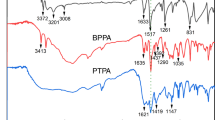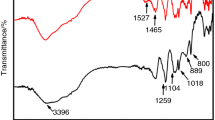Abstract
This paper researches the char forming and flame-retardant effect of silicic poly carbonyl urea (Si-PCU) in company with ammonium polyphosphate (APP) on polypropylene (PP). Si-PCU was firstly synthesized and represented by Fourier transform infrared spectroscopy, energy-dispersive analysis, thermogravimetric analysis and water contact angle. Then, the intumescent flame retardants, Si-PCU + APP, were added into PP. Their flame-retardant effects were studied by limiting oxygen index (LOI) test, UL-94 vertical burning and micro-combustion calorimetry (MCC). When the amount additions of PP, APP and Si-PCU were 70, 20 and 10%, the LOI value of these PP composites (PP-6) was reached 29.5 and UL-94 testing grade was V-0, besides the PHRR decreased 66% and THR decreased 34% compared with pure PP. Furthermore, the residual char layers’ microstructure and strength were researched by field-emission scanning electron microscope, wide-angle X-ray diffraction and laser Raman spectroscopy. They showed that PP-6’s char layer was denser and had higher strength than other PP composites. Finally, tensile tests illustrated that the addition of Si-PCU + APP could decrease the break strength and toughness of pure PP, but Si-PCU + APP/PP had better toughness than APP/PP.












Similar content being viewed by others

References
Zheng L, Wu T, Kong QH, Zhang JH, Liu H. Improving flame retardancy of PP/MH/RP composites through synergistic effect of organic CoAl-layered double hydroxide. J Therm Anal Calorim. 2017;129:1039–46.
Tang S, Jin YJ, Qian LJ. Research progress in intumescent flame retardant. China Plast. 2012;26:1–8.
Zhao PP, Guo CG, Li LP. Flame retardancy and thermal degradation properties of polypropylene/wood flour composite modified with aluminum hypophosphite/melamine cyanurate. J Therm Anal Calorim. 2018. https://doi.org/10.1007/s10973-018-7544-9.
Nie SB, Peng C, Yuan SJ, Zhang MX. Thermal and flame retardant properties of novel intumescent flame retardant polypropylene composites. J Therm Anal Calorim. 2013;113:865–71.
Yang B, Liu H, He BB, Leng JH, Chen X. Effect of novel copolyamide charring agents on flame-retarded polypropylene. Polym Compos. 2013;34:634–40.
Yan H, Zhao ZL, Ge WJ, Zhang NE, Jin Q. Hyperbranched polyurea as charring agent for simultaneously improving flame retardancy and mechanical properties of ammonium polyphosphate polypropylene composites. Ind Eng Chem Res. 2017;56:8408–15.
Almeras X, Dabrowski F, Bras ML, Delobel R, Bourbigot S, Marosi G, Anna P. Using polyamide 6 as charring agent in intumescent polypropylene formulations. Polym Degrad Stab. 2002;77:315–23.
Lu XD, Zhang J, Gu HM, Wang CC. Influences of different char-forming agents on the combustion behavior and fire retardancy of polypropylene/intumescent systems. Plastics. 2006;35:18–22.
Lu C, Gao XP, Yang D, Cao QQ, Huang XH, Liu JC, Zhang YQ. Flame retardancy of polystyrene/nylon-6 blends with dispersion of clay at the interface. Polym Degrad Stab. 2014;107:10–20.
Liu JJ, Liu YQ. The synthesis of slow-release nitrogen fertilizer-polymer carbonyl urea and study of process conditions. North Univ China. 2013;23–46.
Chen JC, Liu YQ, Liu JJ, Sun FY, Zhao GZ, Zhu FT. Environmental friendly and economical synthesis of poly (carbonyl urea) oligomer. Mod Chem Ind. 2011;31:55–9.
Yuan T, Zhao GZ. The synthesis of urea compounds in the presence of carbon dioxide. North Univ China. 2014;25–38.
Li ZD, Li CH, Li GY, Ren RR. How can we benefit from wonderful effects of silane coupling agents. Adhesion. 2009;7:30–6.
Wu K, Song L, Wang ZZ, Hu Y, Kandare E, Kandola BK. Preparation and characterization of core/shell-like intumescent flame retardant and its application in polypropylene. J Macromol Sci A. 2009;46:837–46.
Hamdani S, Longuet C, Perrin D, Lopez-cuesta JM, Ganachaud F. Flame retardancy of silicone-based materials. Polym Degrad Stab. 2009;94:465–95.
Lu SY, Hamerton I. Recent developments in the chemistry of halogen-free flame. Prog Polym Sci. 2012;2002:1661–712.
Hu JH, Zheng XF. Practical infrared spectroscopy. 1st ed. China: Science Press; 2011.
Babrauskas V, Peacock RD. Heat release rate: the single most important variable in fire hazard. Fire Saf J. 1992;18:255–72.
Atabaki F, Keshavarz MH, Bastam NN. The simplest model for reliable prediction of the total heat release of polymers for assessment of their combustion properties. J Therm Anal Calorim. 2018;131:2235–42.
Zou LY, Zhou M, Liu JY, Liu XQ, Chen J, Hu Q, Peng S. Flame-retardant thermoplastic polyester based on multiarm aluminum phosphinate for improving anti-dripping. Thermochim Acta. 2018;664:118–27.
Deng P, Liu YS, Liu Y, Xu CA, Wang Q. Preparation of phosphorus-containing phenolic resin and its application in epoxy resin as a curing agent and flame retardant. Polym Adv Technol. 2017;29:1294–302.
Ge SC. Plastic flame retardant practical technology. Bei Jing: Chemical Industry Press; 2004.
Li Y, Wang XD. Study on synergistic retarding effect of intumescent flame retardant and organic montmorillonite on polypropylene. China Plast. 2010;24:87–91.
Wu K, Yuan H, Song L, Lu HD. Flame retardancy and thermal degradation of intumescent flame retardant starch-based biodegradable composites. Ind Eng Chem Res. 2009;48:3150–7.
Feng CM, Zhang Y, Liu SW, Chi ZG. Synthesis of novel triazine charring agent and its effect in intumescent flame-retardant polypropylene. J Appl Polym Sci. 2012;123:3208–16.
Zheng ZH, Liu Y, Zhang L, Dai BY, Yang XD. Fabrication of halogen-free ammonium phosphate with two components via a simple method and its flame retardancy in polypropylene composites. J Therm Anal Calorim. 2017;127:2013–23.
Li Q, Jiang PK, Su ZP, Wei P, Wang GL, Tang XZ. Synergistic effect of phosphorus, nitrogen, and silicon on flame-retardant properties and char yield in polypropylene. J Appl Polym Sci. 2004;96:854–60.
Pan YY, Ma YQ. Effect of char formation on efficiency of flame retardant polymers. Plast Addit. 2015;4:1–4.
Qian LJ, Han XL, Ye ZY, Ye LJ, Xu GZ. Research on polypropylene composites flame-retarded and reinforced by APP/MCA. China Plast. 2010;24:81–4.
Yuan YY, Chen LG. Synthesis of triazine charring-foaming agents and evaluations on its flame. Tian Jin Univ. 2016;38–45.
Zhou DF, Xie HM, Zhao YL, Wang RS. Graphitizing degree and electrochemical properties of carbonaceous material by phenolic resin pyrolyzing. Funct Mater. 2005;36:83–5.
Cho K, Saheb DN, Yang HC, Kang B, Kim JK, Lee SS. Memory effect of locally ordered a-phase in the melting and phase transformation behavior of b-isotactic polypropylene. Polymer. 2003;44:4053–9.
Bai ZM, Wang X, Tang G, Song L, Hu Y, Yuen RKK. Structure–property relationships of synthetic organophosphorus flame retardant oligomers by thermal analysis. Thermochim Acta. 2013;565:17–26.
Wu Q, Qu BJ. Synergistic effects of silicotungistic acid on intumescent flame-retardant polypropylene. Polym Degrad Stab. 2001;74:255–61.
Chen WY, Yuan SS, Sheng Y, Liu GS. Effect of charring agent THEIC on flame retardant properties of polypropylene. J Appl Polym Sci. 2014. https://doi.org/10.1002/app.41214.
Acknowledgements
We thank the strong supports by the following: the Experiment Center of Polymer Science and Engineering Academy, Sichuan University.
Author information
Authors and Affiliations
Corresponding author
Additional information
Publisher's Note
Springer Nature remains neutral with regard to jurisdictional claims in published maps and institutional affiliations.
Rights and permissions
About this article
Cite this article
Ren, Y., Wei, L., Li, W. et al. Synthesis of silicic poly carbonyl urea and its flame-retardant effect on polypropylene for char forming. J Therm Anal Calorim 137, 1267–1277 (2019). https://doi.org/10.1007/s10973-019-08040-y
Received:
Accepted:
Published:
Issue Date:
DOI: https://doi.org/10.1007/s10973-019-08040-y



